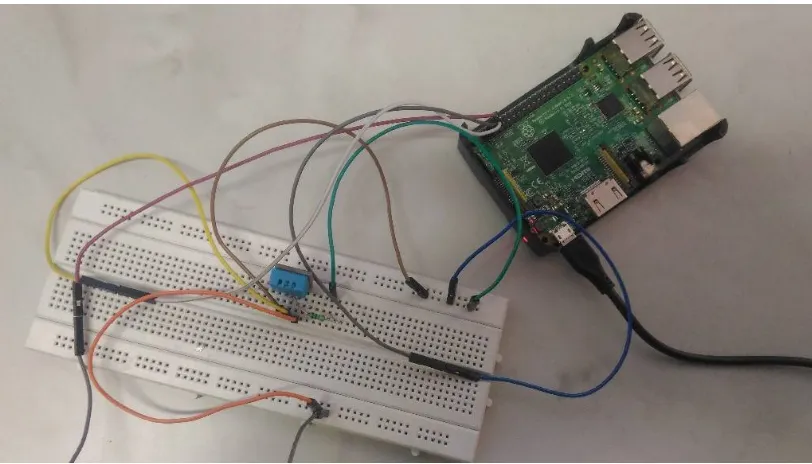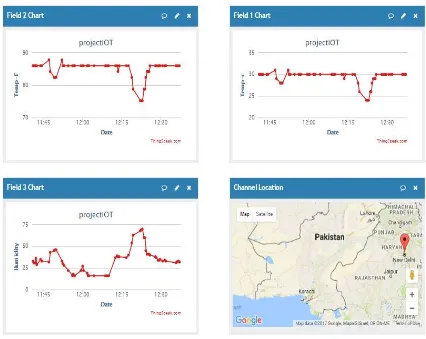ISSN(Online): 2319-8753 ISSN (Print): 2347-6710
I
nternational
J
ournal of
I
nnovative
R
esearch in
S
cience,
E
ngineering and
T
echnology
(An ISO 3297: 2007 Certified Organization)
Website: www.ijirset.com
Vol. 6, Issue 7, July 2017
IoT-based Temperature and Humidity
Monitoring System for Agriculture
Akash1, Amit Birwal2
M.Sc Student, Department of Electronic Science University of Delhi, India1
Assistant Professor, Department of Electronic Science University of Delhi, India2
ABSTRACT: The main objective of this paper is to design an IoT (Internet of Things) based Temperature and Humidity monitoring system for an agricultural environment. Monitoring agricultural environment for temperature, humidity and soil moisture along with other factors is important for a healthy and wealthy cause, which improves the productivity of farmers by using technology driven farming. Taking care of these things manually requires a lots of human work and time and also it is a costly affair. Hence the aim of the project is to make an IoT-based temperature and humidity monitoring system which reduces the human work and taking cares of these factors. The key feature of thiswork is to collected the field data by the sensor and send this to internet web, which can further be analysed using any computer or mobile anywhere on the globe to take real time decision. In this project we controlled a single channel relay on real time basis which can further be used to control water flow on the field.
KEYWORDS: IoT, Raspberry pi, sensors, python, farming, Agriculture
I. INTRODUCTION
The Internet of things (IoT) is the connection of physical devices using internet network. The physical devices can be temperature monitoring system of buildings, emergency SOS system for vehicles and other electronic devices, sensor, software and network connectivity that allows to collect and exchange data.
Internet of Things (IoT) is a hot topic in recent times. Now a day's all the devices are becoming internet connected. Internet provides facility to connect a different kind of devices such as sensors, fitness devices, CCTV cameras etc., and these devices give data to the internet. This data can be access and analysed from any remote location using internet. People are using advantages of embedded system to control and monitoring system for agriculture parameter. Taking care of temperature and humidity are important parameters for obtaining excellent-quality environment. IoT-based monitoring is an effective method in order to improve efficiency and to avoid extra human work.
II. RELATED WORK
IoT can be useful in wide range of applications like Smart home, smart cities, asset tracking and inventory control, shipping and location, Medical devices, security, individual tracking, and energy conservation. As already mentioned IoT allows communication between devices, commonly referred to as Machine -to-Machine communication. With this possibility, physical devices can communicate to people letting them know their condition and where it is located. Devices such as trucks or ships allow the maximum capacity to be filled to the devices by communication amongst devices and then transferring that information to a person to capitalize on the information provided. All of these combined technologies maximize revenue by cutting cost of incapability within the business. Some of the existing methodologies include automated temperature control using LabVIEW and using a PWM system with a transistor, operated with a relay [11].
ISSN(Online): 2319-8753 ISSN (Print): 2347-6710
I
nternational
J
ournal of
I
nnovative
R
esearch in
S
cience,
E
ngineering and
T
echnology
(An ISO 3297: 2007 Certified Organization)
Website: www.ijirset.com
Vol. 6, Issue 7, July 2017
III. ARCHITECTURE OF THE SYSTEM
The main hardware of this system includes Raspberry pi with internet connectivity, Temperature and Humidity sensor. The system is cost effective, low power consuming and easy to operate. The data monitored is collected at the Web server with accurate date and time. The system is designed in such a way that system can work 24x7 and give precise data of temperature and humidity on real time basis. It can also be used in precision farming. The same system setup can also give facility to operate different kinds of devices such as water pumps, located remotely using a Mobile phone from anywhere using internet connectivity. Using these system farmers can switch on and off their pump from their home or where ever they want using their mobile phone.
A. Temperature and Humidity Sensor ( DHT 11)
The DHT11 Temperature & Humidity Sensor is a 4-pin low cost highly reliable sensor. Pin-1 is Vcc, Pin-2 is data pin which collects data from outside world and gives data to the microcontroller. Pin configuration for DHT11 sensor is shown in figure. It features a temperature & Humidity sensor complex with a calibrated digital signal output. It fortifies high reliability and excellent long-term stability. The DHT11 sensor includes a resistive-type humidity measurement component, and connects to a high-performance 8-bit microcontroller, offering excellent quality, fast response, anti-interference ability and cost-effectiveness. Its temperature range is 00-550C and Humidity range is 20-90%.
B. Raspberry Pi
The Raspberry Pi is small size minicomputer used to do small computing and networking operations which can be done by a computer system. Also, it provides GPIO pins due which it becomes the main element in the field of internet of things. It provides access to the internet using wires or wireless connectivity and hence automation of various systems of different devices with remote location becomes possible. Raspberry pi is available in various versions, here we used Raspberry Pi 3 model B, it has a 1.2 GHz 64-bit quad core ARMv8 CPU, and RAM of 1GB. it also has 40 GPIO pins, Full HDMI port, 4 USB ports, Ethernet port, 802.11n wireless LAN connectivity, Bluetooth 4.1 connectivity, Bluetooth low energy, 3.5mm audio jack, video Camera interface (CSI), the Display interface (DSI), and Micro SD card slot.
Figure 2:- Raspberry pi 3 Modal B
C. Raspbian Operating System
The raspbian operating system is an open source and free operating system which is a Debian based Operating system and it is a primary operating system of Raspberry pi. Raspbian provides the basic set of programs and software utilities
ISSN(Online): 2319-8753 ISSN (Print): 2347-6710
I
nternational
J
ournal of
I
nnovative
R
esearch in
S
cience,
E
ngineering and
T
echnology
(An ISO 3297: 2007 Certified Organization)
Website: www.ijirset.com
Vol. 6, Issue 7, July 2017
for operating Raspberry Pi. It comes with more than 35,000 Raspbian packages which are precompiled software ,which provides asmooth and error free installation on Raspberry pi.It has avery good community of developers which runs the discussion forms and provides solutions to many relevant problems. However, Raspbian is still under active development with an emphasis on improving the stability and performance of as many Debian packages as possible.
D. Python ( Programming language)
Python is a programming language that provides an easy and quick way to operate Raspberry pi. It is a powerful programming language that is easy to use (easy to read and write) with Raspberry pi. It provides an excellent way to connect raspberry pi based project with the real world. Python syntax is very clean, with an emphasis on legibility and uses Standard English keywords. Python allows programmers to use fewer lines of code than would be possible
in languages such as assembly, C, or Java. Initially, the Python programming language used as a scripting language for Linux. Python programs contain a series of commands. These programs are executed by the computer from top to bottom same as shell scripts.
IV. EXPERIMENTAL SETUP
A. Block diagram and Prototype of the System
Figure 3:- Block diagram of monitoring system
Raspberry pi
Modal 3 B
DHT11 Sensor
Internet connectivity
(Wired or Wireless) IoT-Platform
(Web-Server)
r
RELAY
Any Device
(EX.
PUMP)
ISSN(Online): 2319-8753 ISSN (Print): 2347-6710
I
nternational
J
ournal of
I
nnovative
R
esearch in
S
cience,
E
ngineering and
T
echnology
(An ISO 3297: 2007 Certified Organization)
Website: www.ijirset.com
Vol. 6, Issue 7, July 2017
Figure 4: - Prototype of monitoring system
B. Working of the system
The system consist a DHT11 sensor, Raspberry pi modal 3 B with internet connectivity. The connection of sensor with pi is shown in the block diagram above with a prototype. In the given system sensor analyze outside temperature and humidity and convert the exact information into a digital signal output. The output obtained from the sensor is fed to the Raspberry pi. Which uses a python program and library to convert information of sensor into numerical values for temperature and humidity? This data is stored in a file over the period of time, which are then placed on internet using IoT. Nowadays lots of free open data IoT platform and other services are available on internet, which can also be done by building a web server. In this project we used one of the IoT cloud service provider named "Thingspeak" that has an application programming interface (API) which has the facility to post and review the data from IoT sensor. Thingspeak facilitates to create a channel (publicly or privately) on which all the data obtained from the sensor is displayed with date and time anywhere on the globe. End user can access this data from anywhere and can control the attached relay.
V.RESULT
ISSN(Online): 2319-8753 ISSN (Print): 2347-6710
I
nternational
J
ournal of
I
nnovative
R
esearch in
S
cience,
E
ngineering and
T
echnology
(An ISO 3297: 2007 Certified Organization)
Website: www.ijirset.com
Vol. 6, Issue 7, July 2017
Figure 5:- Temperature and Humidity Monitoring
VI. CONCLUSION
IoT-Based temperature and humidity monitoring system provide an efficient and reliable system for monitoring agricultural parameters. The corrective action can be taken. IoT-Based monitoring of field not only permits user to reduce the human effort and time, but it also permits user to analyse accurate changes in the atmosphere and for taking possible action. It is cheaper in cost and consumes less power. The GDP per capita in agro sector can be increased. This IoT-based system can be extended for controlling different electronic and electrical apparatus from remote locations and the system can also extended for soil moisture and cattle monitoring.
REFERENCES
[1]Girish Birajdar “Implementation of Embedded Web Server Based on ARM11 and Linux using Raspberry PI” International Journal of Recent Technology and Engineering (IJRTE) ISSN: 2277-3878, Volume-3 Issue-3, July 2014
[2]Raspberry pi-www.raspberrypi.org. [3] www.raspbian.org.
[4]https://thingspeak.com/
ISSN(Online): 2319-8753 ISSN (Print): 2347-6710
I
nternational
J
ournal of
I
nnovative
R
esearch in
S
cience,
E
ngineering and
T
echnology
(An ISO 3297: 2007 Certified Organization)
Website: www.ijirset.com
Vol. 6, Issue 7, July 2017
http://www.collegelib.com/t-raspberry-pi-technologyintro-specifications-seminar-abstract-technicalreport.html [9] Raspberry pi guide [Online]. Available:
http://www.raspberrypi.org/quick-start-guide



